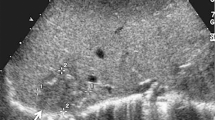Abstract
A 47-year-old man with primary amyloidosis was admitted with abdominal pain. A new radionuclide liver imaging technique using Technetium-99 m diethylenetriamine-pentaacetic acid-galactosyl human serum albumin, was performed and the serum hyaluronate concentration was measured. Although ordinary laboratory tests revealed only slight abnormalities, the uptake of the radiolabelled ligand for hepatocyte asialo-glycoprotein receptors was dereased, and marked hepatomegaly was revealed. Furthermore, the serum hyaluronate level was elevated. Histological examination of a hepatic needle biopsy specimen revealed a marked deposition of amyloid in the hepatic perisinusoidal spaces. These results indicate, that this new radionuclide liver imaging technique (using Technetium-99 m diethylenetriamine-pentaacetic acid-galactosyl human serum albumin) and the measurement of serum hyaluronate may be useful supplementary tools for identifying amyloid deposition in the hepatic perisinusoidal spaces in patients with amyloidosis.
Similar content being viewed by others
References
Levine RA. Amyloid disease of the liver. Correlation of clinical, functional and morphologic features in 47 patients. Am J Med 1962;33:349–57.
Sherlock S. Hepatic amyloidosis. In: Sherlock S (ed) Diseases of the liver and biliary system, 9th edn. London: Blackwell Scientific, 1993;423–425.
Vera DR, Krohn KA, Stadalnik RC, et al. Tc-99m-galactosyl-neoglycoalbumin: In vivo characterization of receptor-mediated binding to hepatocytes. Radiology 1984;151:191–196.
Vera DR, Stadalnik RC, Krohn KA. Technetium-99m galactosyl-neoglycoalbumin: Preparation and preclinical studies. J Nucl Med 1985;26:1157–1167.
Stadalnik RC, Vera DR, Woodle ES, et al. Technetium-99m NGA functional hepatic imaging: Preliminary clinical experience. J Nucl Med 1985;26:1233–1242.
Kudo M, Vera DR, Stadalnik RC, et al. In vivo estimates of hepatic binding protein concentration: Correlation with classical indicators of hepatic functional reserve. Am J Gastroenterol 1990;85:1142–1148.
Kudo M, Todo A, Ikekubo K, et al. Functional hepatic imaging with receptor-binding radiopharmaceutical: Clinical potential as a meausre of functioning hepatocyte mass. Gastroenterol Jpn 1991;26:734–741.
Kudo M, Todo A, Ikekubo K, et al. Quantitative assessment of hepatocellular function through in vivo radioreceptor imaging with technetium 99m galactosyl human serum albumin. Hepatology 1993;17:814–819.
Ueno T, Inuzuka S, Torimura T, et al. Serum hyaluronate reflects hepatic sinusoidal capillarization. Gastroenterology 1993;105:475–481.
Looi L, Sumithran E. Morphological differences in the pattern of liver infiltration between systemic AL and AA amyloidosis. Hum Pathol 19;732–735, 1988.
Buck FS, Koss MN. Hepatic amyloidosis: Morphologic differences between systemic AL and AA types. Hum Pathol 1991;22:904–907.
Benson L, Hemmigsson A, Ericsson B, et al. Magnetic, resonance imaging in primary amyloidosis. Acta Radiol 1987; 28:13–15.
Morell AG, Irvine RA, Sternlieb I, et al. Physical and chemical studies on ceruloplasmin. V. Metabolic studies on sialic acidfree ceruloplasmin in vivo. J Biol Chem 1968;243:155–159.
Geuze HJ, Slot JW, Strous GJAM. Intracellular site of asialoglycoprotein receptor-ligand uncoupling: Double-label immunoelectron microscopy during receptor-mediated endocytosis. Cell 1983;32:277–287.
Schwartz AL. Trafficking of asialoglycoproteins and the asialoglycoprotein receptor. Targeted Diagn Ther 1991;4:3–39.
Harada M, Sakisaka S, Yoshitake M, et al. Ultrastructure of intracellular membranous system and intracellular transport of asialoglycoproteins in rat hepatocytes. J Electron Microsc 1992;41:458–464.
Bion E, Brenard R, Pariente EA, et al. Sinusoidal portal hypertension in hepatic amyloidosis. Gut 1991;32:227–230.
Martinez-Hernandez A, Martinez J. The role of capillarization in hepatic failure: Studies in carbon tetrachloride-induced cirrhosis. Hepatology 1991;14:864–874.
Gertz MA, Kyle RA. Hepatic amyloidosis (primary [AL], immunogloblin light chain): The natural history in 80 patients. Am J Med 1988;85:73–80.
Sherlock S. Iron overload states. In: Sherlock S (ed) Diseases of the liver and biliary system, 9th edn. London: Blackwell Scientific, 1993;390–399.
Sherlock S. Wilson's disease. In: Sherlock S (ed) Diseases of the liver and biliary system. 9th edn. London: Blackwell Scientific, 1993;400–407.
Sherlock S. Nutritional and metabolic liver disease. In: Sherlock S (ed) Diseases of the liver and biliary system. 9th edn. London: Blackwell Scientific, 1993;408–433.
Eriksson S, Fraser JRE, Laurent TC, et al. Endothelial cells are a site of uptake and degradation of hyaluronic acid in the liver. Exp Cell Res 1983;44:223–228.
Smedsrod B, Pertoft H, Eriksson S, et al. Studies in vitro on the uptake and degradation of sodium hyaluronate in rat liver endothelial cells. Biochem J 1984;223:617–626.
Fraser JRE, Alcorn D, Laurent TC, et al. Uptake of circulating hyaluronic acid by the rat liver: Cellular localization in situ. Cell Tissue Res 1985;242:505–510.
McGray CT, Raja RH, Weigel PH. Endocytosis of hyaluronic acid by rat liver endothelial cell. Evidence for receptor recycling. Biochem J 1989;257:875–884.
Author information
Authors and Affiliations
Rights and permissions
About this article
Cite this article
Hashimoto, O., Harada, M., Sata, M. et al. Functional liver imaging with asialoglycoprotein receptors and serum hyaluronate in a patient with amyloidosis. J Gastroenterol 30, 403–407 (1995). https://doi.org/10.1007/BF02347519
Received:
Accepted:
Issue Date:
DOI: https://doi.org/10.1007/BF02347519




